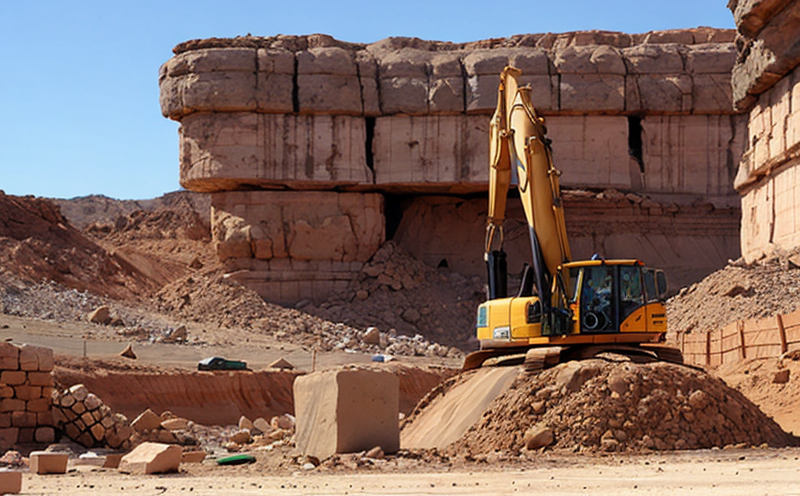DIN 18121 Porosity and Density of Rock Specimens
The DIN 18121 standard provides a comprehensive approach to determining the porosity and density of rock specimens, which is crucial for understanding their mechanical properties and behavior under various conditions. This testing method ensures that materials used in mining operations meet specified quality standards, thereby enhancing safety and efficiency.
Porosity and density are fundamental characteristics that influence how rocks behave in different environments and applications. For instance, porosity affects the permeability of rock formations, which is critical for understanding fluid flow through geological structures. Density impacts the weight-bearing capacity and stability of mine structures. Accurate measurement of these properties ensures reliable engineering decisions.
The testing procedure outlined in DIN 18121 involves several steps to ensure precision and reliability. Specimens are first prepared according to standard practices, ensuring uniformity across multiple samples. The density is determined using various methods depending on the type of rock, including water displacement or pycnometer techniques. Porosity measurements typically involve gas absorption tests or helium pycnometry.
The importance of this test extends beyond mere compliance with standards; it plays a pivotal role in optimizing mining processes and ensuring product quality. By accurately measuring porosity and density, engineers can better predict the performance of rocks under stress, which is essential for designing safer and more efficient mines. This information also aids in selecting appropriate materials for specific applications within the mine environment.
One key aspect of DIN 18121 testing is its emphasis on repeatability and reproducibility. The method specifies conditions under which tests should be conducted to minimize variability, ensuring consistent results across different laboratories or facilities. This consistency is vital when comparing data from various sources or over time.
Another critical element of the standard is its focus on accuracy. Precision instruments and careful sample preparation are essential for obtaining reliable measurements. The use of advanced equipment allows for high-precision readings that can be trusted in decision-making processes. Moreover, regular calibration of these instruments ensures ongoing accuracy throughout their lifecycle.
The significance of DIN 18121 testing cannot be overstated, particularly given the diverse range of rock types encountered in mining operations worldwide. From sedimentary to igneous rocks, each type presents unique challenges requiring tailored approaches when conducting porosity and density tests. Understanding these nuances through rigorous testing helps tailor solutions that best suit particular operational needs.
By adhering to DIN 18121 standards, miners can ensure they are making informed choices about which materials will perform optimally in challenging environments. This knowledge translates into better project planning, reduced risk of failure, and ultimately more successful mining ventures.
Benefits
The benefits of conducting DIN 18121 porosity and density tests extend far beyond mere compliance with industry standards. These tests provide valuable insights into the mechanical properties of rocks, enabling informed decision-making throughout various stages of mining operations.
- Enhanced Safety: Accurate knowledge about rock mechanics reduces risks associated with unstable structures or potential failures during excavation and processing.
- Improved Efficiency: Understanding how different types of rock behave under stress allows for optimized extraction methods, reducing downtime and increasing productivity.
- Better Material Selection: By knowing the specific characteristics of rocks being used in construction projects within mines, engineers can choose materials that are best suited to their intended purpose.
- Cost Savings: Properly executed tests help avoid costly mistakes by ensuring selected materials meet required specifications before implementation.
In summary, DIN 18121 porosity and density testing offers numerous advantages that contribute directly to the success of mining operations. From enhancing safety measures to improving overall efficiency, this standardized approach ensures reliable results critical for effective management practices.
Why Choose This Test
- Comprehensive Standard: DIN 18121 provides a detailed protocol for measuring porosity and density, ensuring consistent and accurate results across different laboratories.
- Reproducibility: The specified conditions guarantee that tests can be repeated with the same outcome, enhancing trustworthiness of findings.
- Advanced Equipment: Utilizing state-of-the-art instrumentation allows for precise measurements necessary for robust engineering decisions.
- International Recognition: Adherence to this standard ensures compatibility with global benchmarks, facilitating international collaboration and trade.
By opting for DIN 18121 porosity and density testing, organizations demonstrate their commitment to maintaining high standards of quality control. This not only enhances internal processes but also builds credibility among stakeholders both locally and internationally.
Competitive Advantage and Market Impact
Implementing DIN 18121 porosity and density testing offers significant competitive advantages in the mining industry, contributing to sustained market leadership. The ability to accurately assess rock properties provides a clear edge over competitors who may rely on less precise methods or outdated practices.
- Precise Decision-Making: Accurate data enables better informed decisions regarding material selection and process optimization, leading to higher quality outputs at lower costs.
- Risk Mitigation: Understanding rock behavior helps mitigate risks associated with structural integrity issues, minimizing downtime and ensuring continuous operation.
- Innovation Opportunities: Insights gained from these tests can inspire new approaches in mine design and operational strategies, fostering innovation within the organization.
The broader market impact of adopting DIN 18121 lies in its contribution to industry-wide improvements. By setting a high standard for quality assurance, mining companies that embrace this approach set benchmarks others strive to meet. This not only elevates overall performance across sectors but also promotes safer working conditions and more sustainable practices.





